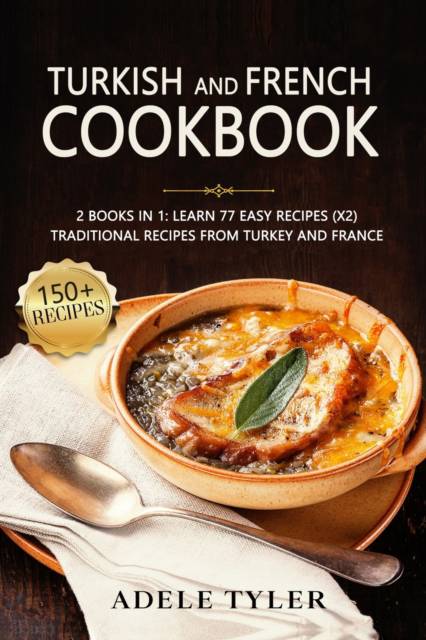
- Retrait gratuit dans votre magasin Club
- 7.000.000 titres dans notre catalogue
- Payer en toute sécurité
- Toujours un magasin près de chez vous
- Retrait gratuit dans votre magasin Club
- 7.000.000 titres dans notre catalogue
- Payer en toute sécurité
- Toujours un magasin près de chez vous
Turkish And French Cookbook
2 Books In 1: Learn 77 Easy Recipes (x2) Traditional Recipes From Turkey And France
Adele TylerDescription
In the first book, French Home Cooking, you will learn traditional and modern French recipes.
Paris. Croissant. The most delicious pastry. Fancy food. Michelin started restaurants. French Riviera and Normandy shores. All this and a lot more is France.
The history of French cuisine goes way back in the centuries and it is told that the first professional cooks - chef, nowadays - have been started to work 700 years ago, for the Kings of France and their court.
The French cuisine is rich and gorgeous. The territory is generous and the country has always been relatively prosperous, therefore the ingredients have always been expensive and not second cuts. While Italian cuisine is historically based on poor dishes made of leftovers and less fancy meat and fish cuts, French cooking rhymes with fancy ingredients like fois gras, scallops, oysters and escargot.
Also famous for its pastry, the French desserts are gorgeous, enriched sweet fillings and served from breakfast to dinner as one of the very best assets of the country.
In French Home Cooking by Adele Tyler you will learn:
- History of French food and its evolution
- Over 80 recipes from the most authentic French cuisine
- How to cook French dishes at home
- French pastry cookbook for homemade croissant, baguette and bread with chocolate
If you want to cook French dishes at home to impress family and friends, this cookbook is for you!
In the second book, Turkish Cookbook, you will learn how to prepare traditional and modern Turkish recipes.
It is easy to think about kebab - or kebap, you will learn more about that later! - when Turkish cuisine gets into the conversation. Unsurprisingly though there is a wide world of flavors behind the most icon Turkish dish. The Turkish cuisine is definitely not only kebab, but it has several dishes that are a strong statement of integration between mediterranean, balkans and Middle Eastern's influences.
Even within Turkey itself, the cuisine has different twist. In Istanbul, Bursa and the rest of Asia Minor region it has inherited many Ottoman elements, such as usage of vegetables, stews and stuffed dolmas. In the Black Sea region instead the fish is prevalent. In the Southeast kebab and mezes, along side dough based desserts, are the key of the local nutrition. Mediterranean influence is strong on the coasts, with wide usage of olives, olive oil, rice, bread and vegetables.
Back to kebab, there's a slight difference between "kebab" and "kebap", but it doesn't involve the ingredients, while more the region. If "kebab" is strictly Turkish, "kebap" is a variant that is more easily found in Medina or Damascus.
In Turkish Cookbook by Adele Tyler you will find:
- Over 77 recipes for Turkish traditional food
- History of traditional Turkish food
- How to prepare kebab at home
- Kebab recipes cookbook
Even if kebab will hardly become an healthy dish, prepare it at home grants a better dosage of the ingredients and along side dozens of other tasty dishes, you will impress family and friends with original and entertaining recipes.
Scroll up, click on buy it now and get your copy today!Spécifications
Parties prenantes
- Auteur(s) :
- Editeur:
Contenu
- Nombre de pages :
- 208
- Langue:
- Anglais
Caractéristiques
- EAN:
- 9798707681509
- Date de parution :
- 15-02-21
- Format:
- Livre broché
- Format numérique:
- Trade paperback (VS)
- Dimensions :
- 152 mm x 229 mm
- Poids :
- 285 g







